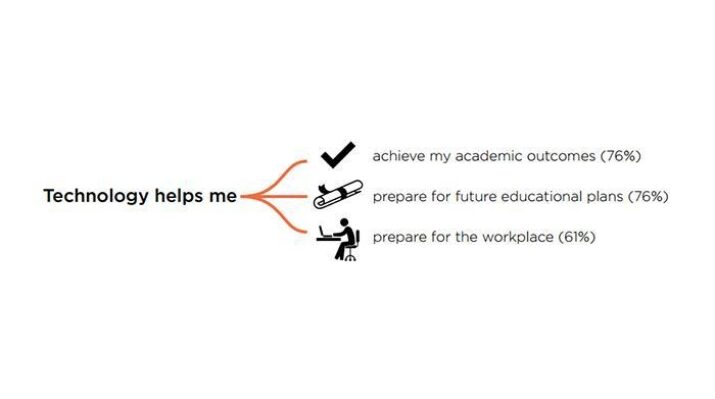Is Technology a Natural Enabler of Student Success?
Topics

Educators often take advantage of educational technologies as they make the shifts in instruction, teacher roles, and learning experiences that next gen learning requires. Technology should not lead the design of learning, but when educators use it to personalize and enrich learning, it has the potential to accelerate mastery of critical content and skills by all students.
Technology is already integral to students’ higher education experience, but is it a natural enabler of student success? In this post, learn how an innovation enabled by technology can fit with best practices for promoting student success.
Technology is already integral to students’ higher education experience, but is it a natural enabler of student success? In this post, I share what I learned from my NGLC-related research about how an innovation enabled by technology fits with best practices for promoting student success.
Students see the benefits of technology in their studies
According to the EDUCAUSE Center for Analysis and Research’s 2013 Study of Undergraduate Students and Information Technology:

Technology can extend your reach beyond the classroom
When you use technology to support a student success innovation, you can potentially bolster its reach and benefits across a campus and even across multiple institutions.
Technology can facilitate student success design principles
The Center for Community College Student Engagement presented a core set of design principles that heighten the impact of student success initiatives in A Matter of Degrees: Promising Practices for Community College Student Success (A First Look).
These design principles help institutions maximize their efforts, and are laid out below. For each, I offer just one illustration of the various ways that technology can facilitate the design principle.
- Ensuring the students’ earliest college contacts and first weeks incorporate experiences that foster personal connections with their institution:
Customized email messages gleaned from demographics and performance data that offer students encouragement and recommend tailored support resources, like E2Coach from the University of Michigan Department of Physics - Creating clear, coherent pathways that help students navigate towards degree completion and graduation:
Online advising systems, such as the University of Hawaii’s STAR, that engage students real time during course selection to help them to understand the effect of their choices on degree completion. - Building support, such as skill development and supplemental instruction, directly into coursework:
Pairing parent courses with technology-enhanced supplemental instruction that provide adaptive, self-paced learning in areas like developmental math, like the Hybrid Lab model from CSU Northridge - Setting high, but attainable, academic standards while providing a strong underlying support structure (e.g., academic planning, academic support, financial aid):
Automated early alert systems, such as the Student Success Plan developed at Sinclair Community College, that use learning analytics (the measurement, collection, and analysis of data) from student information and learning management system data to identify students at academic risk and connect them with instructors and supplemental online resources - Promoting student engagement in the collegiate experience:
Online social networks to create learning communities for students to ask questions and get immediate feedback from peers, including OpenStudy - Scaling practices to amplify efforts and impact:
Computer generated simulations of resources, like the science labs of WICHE’s North American Network of Science Labs Online (NANSLO), for remote access by students in multiple courses and institutions - Professional development to help faculty, staff, administrators, governing boards, and students to re-conceptualize their roles and work differently to meet student success goals:
Online, freely accessible, digital educational resources—like course content, student activities, and assessment tools—to create blended learning courses with face-to-face and online elements, as Cerritos Community College has done with Thanos Partners (and now Lumen Learning) in Project Kaleidoscope
Technology can enhance institutional student success programs
Technology solutions are not a panacea. They must be part of a larger, overarching effort to provide students with the support they need to be successful, including coordinated systems and personal interactions with faculty and staff.
However, as demonstrated by these examples, technology can boost institutional efforts to identify and communicate with at-risk students and to provide real-time support at levels that would be near impossible to accomplish without the aid of technology-based resources.
The key lies in developing innovative solutions where technology capitalizes on institutional resources and culture. But this can be a perplexing proposition, especially for institutions embarking on initial efforts. In a recent post, 7 Ways to Use Tech to Improve College Student Success, Kristen Vogt provided guidance through seven lessons learned. These lessons were gleaned from the experiences and outcomes of the 29 grant recipients funded by NGLC in its first wave of investment, which is summarized in this infographic.
In my next post, I’ll dive into the first lesson learned from the grant recipients and their work: Innovations that required specific instructional changes achieved the greatest impact.
This is the second post in a series on technology-enabled innovations designed to promote student success. Read the first post and view the infographic summarizing the findings from NGLC’s first wave of grantmaking. All findings are drawn from an external evaluation conducted by SRI International as well as grant recipients' results and observations.




